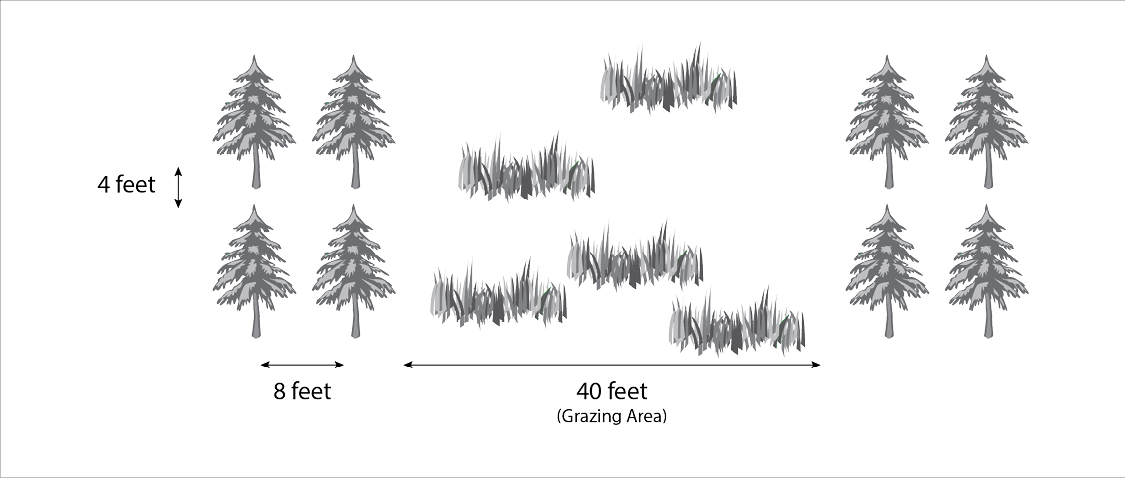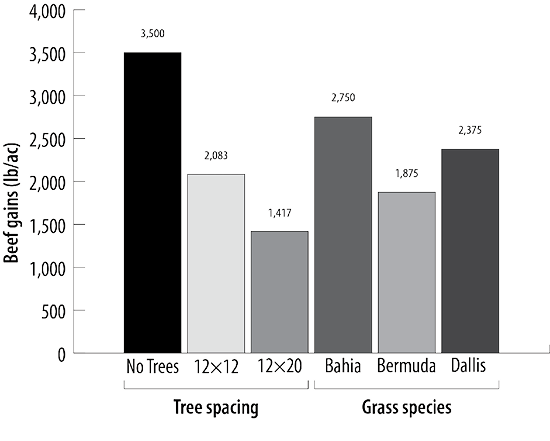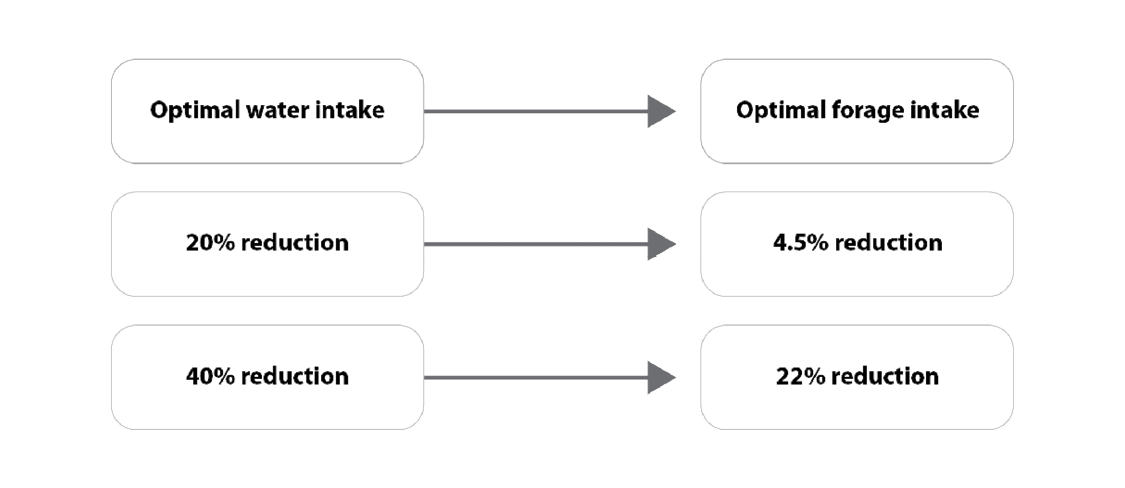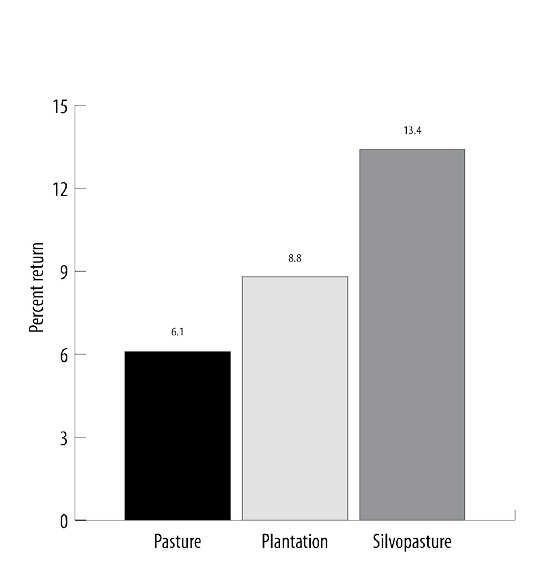Silvopasture: Grazing Systems Can Add Value to Trees
Forests occupy more acres than all cropland and pastures combined in Mississippi. Commercial forests cover 19.6 million acres and more than 62 percent of Mississippi’s total land area. By the same token, beef production is an important agricultural enterprise in the state. Many landowners are accustomed to managing their forestland or pastureland for a single purpose.
Silvopasture is a system of integrating trees or shrubs with forage and livestock production in the same acreage to use space, growing season, and growth factors more efficiently. The goal of a silvopastoral system is to optimize, rather than maximize, production of all three components. A properly managed silvopastoral operation could enhance soil protection and increase long-term income with the simultaneous production of trees and grazing animals.
Silvopastoral systems can be implemented in pastures by adding trees or shrubs; in forested areas by adding forages; or on land that has neither the desired trees nor forages in sufficient quantity to meet the land use objectives. Appropriate establishment methods depend on site conditions, tree species, age, spacing, and existing pasture conditions (climate, terrain, type of livestock, labor requirements, fencing, water supplies, and other vegetation). Tree spacing is an important factor in a silvopastoral system (Tables 1a–1d).
|
Tree to tree in row space (foot)[3] |
||||
|
Row set |
Row spacing |
6 |
8 |
10 |
|
One |
6, 8, 10, 12[4] |
(484) |
363 |
290 |
|
Two |
6 |
(691) |
(518) |
(414) |
|
8 |
(631) |
(473) |
378 |
|
|
10 |
(580) |
(435) |
348 |
|
|
12 |
(537) |
(403) |
322 |
|
|
Three |
6 |
(807) |
(607) |
(484) |
|
8 |
(703) |
(528) |
(422) |
|
|
10 |
(622) |
(468) |
374 |
|
|
12 |
(558) |
(418) |
335 |
|
|
Tree to tree in row space (foot)[3] |
||||
|
Row set |
Row spacing |
6 |
8 |
10 |
|
One |
6, 8, 10, 12[4] |
363 |
272 |
218 |
|
Two |
6 |
(558) |
(418) |
335 |
|
8 |
(518) |
388 |
311 |
|
|
10 |
(484) |
363 |
290 |
|
|
12 |
(454) |
340 |
272 |
|
|
Three |
6 |
(680) |
(512) |
(409) |
|
8 |
(605) |
(455) |
363 |
|
|
10 |
(545) |
(409) |
327 |
|
|
12 |
(495)] |
372 |
297 |
|
|
Tree to tree in row space (foot)[3] |
||||
|
Row set |
Row spacing |
6 |
8 |
10 |
|
One |
6, 8, 10, 12[4] |
242 |
182 |
145 |
|
Two |
6 |
(403) |
303 |
242 |
|
8 |
382 |
287 |
229 |
|
|
10 |
363 |
272 |
218 |
|
|
12 |
345 |
259 |
207 |
|
|
Three |
6 |
(512) |
390 |
311 |
|
8 |
(437) |
356 |
284 |
|
|
10 |
(435) |
328 |
262 |
|
|
12 |
(403) |
303 |
242 |
|
|
Tree to tree in row space (foot)[3] |
||||
|
Row set |
Row spacing |
6 |
8 |
10 |
|
One |
6, 8, 10, 12[4] |
182 |
136 |
109 |
|
Two |
6 |
315 |
337 |
189 |
|
8 |
303 |
227 |
182 |
|
|
10 |
290 |
218 |
174 |
|
|
12 |
279 |
209 |
167 |
|
|
Three |
6 |
(419) |
315 |
252 |
|
8 |
389 |
292 |
234 |
|
|
10 |
363 |
273 |
218 |
|
|
12 |
340 |
256 |
204 |
|
Notes
[1] Landscape and planting design may cause some variation in planting rates.
[2] Source: Adapted from Robinson and Clason, 2000.
[3] Figures in parentheses are outside the recommended planting rates (100 to 400 trees/acre) for silvopasture.
[4] Row spacing and alley width are the same for the single row sets.
Silvopasture establishment requires a number of different management steps depending on previous land use, including thinning, prescribed burning, and pruning. Planting trees in an existing improved pasture is the easiest way to start the system. Another possible scenario is to thin existing timber stands and plant or seed forage species among the remaining trees. Adequate soil fertility, proper pH, and well-developed structure provide the foundation for a productive silvopastoral system. Other building blocks include proper drainage and erosion control. Regular soil testing will help indicate when additional fertilizer or lime is needed to support forage production.
What Tree Species and Planting Patterns Can Be Used?
In the southeastern United States, most commercially grown southern pines (loblolly, slash, shortleaf, and longleaf) are suitable for silvopastoral systems. Among southern pine species, slash pine is the most suitable for silvopasture because of its light crowns and good self-pruning abilities. However, trees with these characteristics are also suitable:
- fast-growing and open-crowned to allow good forage production
- deep-rooted to avoid competition with forage for moisture
- drought-tolerant
- genetically improved to resist pests and diseases
- capable of providing high-quality timber
- nut- and fruit-producing marketable hardwoods, such as pecan, walnut, and olive
For silvopasture, trees are planted or thinned to provide sufficient light for good forage production. Grouping trees into rows or clusters concentrates their shade and root effects while providing open spaces for pasture production. When trees exceed about 35 percent canopy cover, forage production falls off rapidly. Trees that provide shade or wind protection for livestock can have a climate-stabilizing effect by reducing heat stress and wind-chill. Some studies have shown that tree protection can cut the direct cold effect by 50 percent or more and reduce wind velocity by as much as 70 percent. Under these conditions, livestock might require less energy and their performance could be improved.
Determining the desired row spacing for trees in a silvopastoral system is important. Commercially valuable timber trees are typically planted equidistant in a traditional grid pattern. The grid pattern spreads the trees out, minimizing competition between trees and maximizing competition between trees and the forage vegetation. Planting rates from 100 to 400 trees per acre are typically recommended for silvopastoral systems. Trees may be grown in single rows or in two or three aggregate rows (called sets) with wide alleys for forage production between sets. Two- and three-row sets could be planted on 6-, 8-, 10-, and 12-foot centers (Tables 1a–1d).
Trees planted in rows often perform poorly if they do not have at least one side in full sun. Single or double rows are generally preferred over triple rows. In Florida and Georgia, two-row tree spacing with 40-foot alleys between pairs of tree rows (known as 4-by-8-by-40-foot spacing) has been found to satisfy forage and timber growth requirements (Tables 2a and 2b and Figure 1). This spacing provides wide-open alleys for forage production and easy access for livestock grazing, hay harvesting, fertilizer spreading, spraying, and other agricultural practices. If trees are planted into an established pasture, rows should be oriented east to west when possible to allow for maximum sunlight exposure on the forage strips.
|
Tree Spacing (feet) |
|||
|
Tree Characteristics |
8×12 |
4×24 |
2×48 |
|
Survival (%) |
61 |
68 |
68 |
|
Height (ft) |
35 |
35 |
36 |
|
Diameter (in) |
5.7 |
5.2 |
5.1 |
|
Stand basal area (ft2/ac) |
50 |
49 |
52 |
|
Total Forage Production |
1,138 |
542 |
1,069 |
|
Tree Spacing (feet) |
|||
|
Tree Characteristics |
6×8×24 |
4×8×20 |
2×8×20 |
|
Survival (%) |
67 |
67 |
74 |
|
Height (ft) |
32 |
36 |
34 |
|
Diameter (in) |
5.0 |
5.5 |
4.3 |
|
Stand basal area (ft2/ac) |
40 |
59 |
33 |
|
Total Forage Production |
1,347 |
1,264 |
2,573 |
Notes
[1] Source: Lewis et al., 1984.

What Forage Species Fit a Silvopastoral System?
Forage species should be selected based on perenniality, suitability for grazing, compatibility with the site characteristics (soil, temperature, and precipitation), productivity under partial shade and moisture stress, responsiveness to intensive management, and tolerance to heavy use. On areas where a new silvopasture will be put in place, establishing the pasture first is recommended. This will allow for soil preparation and ample room for the equipment needed for pasture establishment. It is a much simpler operation to spray out small strips or spots for tree planting.
A variety of perennial warm- or cool-season grasses and legumes can be used in silvopasture. Many landowners have adopted these systems using tall fescue, bahiagrass, and common and coastal bermudagrass. They tolerate partial shade and avoid competition with trees by growing in different seasons or rooting at different depths. Pensacola bahiagrass, coastal bermudagrass, and dallisgrass have shown to have good forage production under a tree canopy (Figure 2). It has been reported that dallisgrass could be more sensitive to shading conditions than bahiagrass or bermudagrass. Some forage species tend to be lower in fiber and more digestible when grown in a tree-protected environment because they are more shaded and maintain more vegetative growth.

Cool-season annual grasses (such as annual ryegrass, rye, wheat, and oats) could be overseeded in silvopasture between wide-spaced rows of trees and legumes to extend the grazing period. Examples of cool-season nitrogen-fixing species that could be used in silvopastoral systems include vetches and crimson, red, arrowleaf, and white clovers. Incorporation of these species into the overall system may reduce the need for nitrogen fertilization of warm-season forages and trees. For cool-season grasses, shade tolerance of some species might exceed 60 percent and still produce good forage yields. Depending upon the species of grass, trees might need thinning to keep canopy cover below the maximum shade tolerance level. There are a variety of commercially available instruments that measure light penetration, canopy cover, and canopy closure to make sure that the microclimatic conditions are desirable for particular forage species to sustain growth and persistence.
What Type of Livestock Will Optimize Production?
The selection of livestock suitable for a particular silvopastoral system will depend on landowner objectives and markets, as well as tree and forage species established. Beef cattle and sheep are the livestock of choice for many landowners, although other species, such as goats, horses, and deer (by permit) also have potential. Certain breeds of cattle may fare better in a silvopastoral system than others. Cattle are more likely to trample young trees or compact wet soils, while sheep are more likely to browse trees. Careful observation of herd behavior is necessary to detect and correct potential problems.
What Are the Water and Fencing Requirements?
It is important that the location and distribution of water, minerals, and supplemental feed are adequate to avoid overuse of the silvopasture areas. Water supply options for silvopasture include wells, creeks, ponds, spring developments, and even municipal or rural water systems. Water requirements vary for the kind, size, age, and breed of livestock. In a silvopastoral system, consider installing water so that animals do not have to travel more than 600 feet to get to it. Animals acquire water through drinking and from the moisture in the forage they eat. As air temperature increases, water requirements also increase. The need for available drinking water is compounded because forages become drier at higher temperatures, and reduced water intake can directly affect forage intake (Figure 3). One distinct advantage of a silvopastoral system is that shade is distributed throughout the pasture, which greatly reduces temperature stress on livestock.
Electric fencing or individual tree guards may be necessary to protect trees if animals are introduced when trees are still small. Fencing is also used in rotational grazing methods to better control forage consumption. High-tensile wire is recommended when using energized fences for border areas and cross fencing. The number of strands depends upon the type of livestock being grazed. Generally, a minimum of four to six strands is recommended for border fencing and one to three strands for cross fencing cattle. An energized fence is primarily a barrier and can only be effective if the fence carries enough current to deliver a “deterrent” shock. Have a properly sized energizer.

What Type Grazing Management Is More Suitable in a Silvopastoral System?
Livestock grazing should be closely managed. It requires understanding forage growth characteristics and managing the timing and duration of grazing to avoid browsing of young tree seedlings or elongating shoots. Delay grazing until the average height of the tree’s terminal bud exceeds the browsing height of the livestock or is thick enough to resist breakage. This will minimize damage by trampling and rubbing. Until trees are large enough to allow grazing, forage areas could be used for hay production.
Overgrazing could impede the establishment of desirable woody and herbaceous species. Overgrazing increases the potential for soil compaction, which decreases water infiltration and soil aeration. These effects decrease the health and vigor of trees.
As in any other managed grazing system, fertilizer should be applied based on soil test recommendations to maintain optimum forage production. Some studies have shown a 20–30 percent increase in stem production in response to fertilizer management for forage production. Grazing can control grass competition for moisture, nutrients, and sunlight, and subsequently enhance tree growth. Well-managed grazing provides economical control of weeds and brush by eliminating or reducing herbicide use.
Continuous grazing is not recommended for silvopastoral systems. Develop a rotational grazing system in which pastures are grazed and rested in a planned sequence. The grazing management plan should maintain an adequate balance between livestock numbers and forage production. Make paddocks as near to square as possible, and follow landscape lines for paddock boundaries. Also, make paddocks of similar carrying capacity, and plan lanes for livestock movement.
What Are the Economic Benefits of Incorporating a Silvopastoral System?
In the long-term, silvopastoral systems could provide economic advantages. Integrating tree, forage, and livestock production creates a management system that provides different marketable products. Comprehensive and well-managed land use in a silvopastoral system could generate a short-term cash flow from livestock sales and selective sales of trees or timber products, and in the long-term produce a high-value timber component. Silvopasture can improve the overall economic performance of a farm enterprise through diversification. The benefits primarily involve those gained in forage production in combination with tree spacing and timber production that will increase internal rates of return (Figure 4).

Summary
In a silvopastoral system, matching the tree and forage species to the site is critical. Silvopasture is usually established by planting trees in existing pastures. This eliminates costs of forage establishment, shrub and brush control, or removal of timber harvest residues. Careful herd management is extremely important to the success of a silvopastoral system. Adequate fence and water systems facilitate the rotational grazing of livestock through a series of pastures. This is essential to successfully managing the forages as well as the trees in a silvopastoral system. Before new silvopastoral systems are established, implications of merging forestry and agricultural systems should be explored thoroughly for economic and environmental considerations. Also consider local land use, zoning, cost-share programs, and tax regulations. Silvopastoral systems are designed to provide short-term cash flow from the livestock operation while producing a high-value timber component in the long term.
References
Brantly, S. 2013. What is silvopasture? USDA National Agroforestry Center. (Accessed 22 May 2014)
Brantly, S. 2005. Silvopasture water and fencing systems for cattle. Agroforestry Notes (February). USDA Forest Service. (Accessed 22 May 2014)
Byrd, N.A, and Lewis, C.E. 1983. Managing pine trees and bahiagrass for timber and cattle production. USDA Forest Service. General Report R8-GR 2.
Byrd, N.A., Lewis, C.E., and Pearson, H.A. 1984. Management of southern pine forests for cattle production. USDA Forest Service. General Report R8-GR 4.
Clason, T.R. 1995. Economic implications of silvopastures on southern pine plantations. Agroforestry Systems, 29: 227-238. (Accessed 22 May 2014).
Clason, T.R. 1998. An ongoing study to understand tree, forage, and livestock systems. Inside Agroforestry (Summer). USDA Forest Service.
Clason, T.R. 1999. Silvopastoral practices sustain timber and forage production in commercial loblolly pine plantations of northwest Louisiana. USA. Agroforestry Systems, 44: 293-303. (Accessed 22 May 2014)
Clason, T.R., and S.H. Sharrow. 2000. Silvopastoral Practice. pp. 119-148. In: Garrett, G.E., W.J. Rietveld, and R.F. Fisher (Eds.). North American Agroforestry—An integrated science and practice. American Soc. Agronomy, Madison, WI.
Grado, S.C., Hovermale, C.H., and St. Louis, D.G. 2001. A financial analysis of silvopasture in southern Mississippi. Agroforestry Systems, 53: 313-322.
Jennings, S.B., Brown, N.D., and Sheil, D. 1999. Assessing forest canopies and understory illumination: canopy closure, canopy cover, and other measures. Forestry 72 (1): 59-73.
Karki, U., and Goodman M.S., 2010. Cattle distribution and behavior in southern-pine silvopasture versus open-pasture. Agroforestry Systems, 78:159-168. (Accessed 22 May 2014).
Klofestein, N.B., T.R. Clason, S.H. Sharrow, G. Garrett, and B.E. Anderson. 1997. Silvopasture: An agroforestry practice. Agroforestry Notes (November). USDA Forest Service.
Lemus, R. 2009. Silvopasture: How a grazing system can add value to trees. Forage News. (Accessed 22 May 2014)
Lewis, C.E., Tanner, G.W., and Terry, W.S. 1985. Double vs. single-row pine plantations for wood and forage production. Southern Journal of Applied Forestry. Vol 9 (1): 55-60.
Lewis, C.E., and Pearson, H.A. Agroforestry using tame pastures under planted pine. In: Gholz, H.L. (ed.). Agroforestry: Realities, Possibilities, and Potentials.
Nowak. J., Blount, A., and Workman, S. 2002. Integrated timber, forage, and livestock production—Benefits to silvopasture. Univ. of Florida Coop. Ext. Serv. Cir1430. (Accessed 22 May 2014).
Nowak, J., Long, A., and Blount, A. 2012. Establishment of silvopasture in existing pastures. Univ. of Florida Coop. Ext. Serv. FOR107. (Accessed 22 May 2014).
Robinson, J.L., and Clason, T. 2000. From a pasture to a silvopasture system. Agroforestry Notes (December). USDA Forest Service.
Sharrow, S.H. 1997. The biology of silvopastoralism. Agroforestry Notes (November). USDA Forest Service.
Sharrow, S.H. 1999. Silvopastoralism: Competition and facilitation between trees, livestock, and improved grass-clover pastures on temperate rainfed lands. In: Buck, Louise, J.P. Lassoie, and E.C.M. Fernandes (Eds.). Agroforestry in sustainable agricultural systems. pp.111-130.
Sharrow, S.H. and R. Fletcher. 2003. Converting a pasture to a silvopasture in the Pacific Northwest. Agroforesty Notes (September). USDA Forest Service. (Accessed 22 May 2014).
Stuhr, K. 2002. Silvopasture: Gaining momentum in the south. Inside Agroforesty (Fall). USDA Forest Service.
United States Department of Agriculture (USDA), National Agroforestry Center. 2000. Working trees for livestock: Silvopasture in the southeast.
USDA, Natural Resource Conservation Service (NRCS). 2005. Conservation Practice Information Sheet IS-MO381: Silvopasture establishment and management.
USDA, NRCS. 2006. Silvopasture establishment. Conservation Practice Standard. Code 381-1.
Workman, S.W., Long, A.J., Moham, S., and Monroe, M.C. 2011. Agroforesty: Options for landowners. University of Florida Cooperative Extension Service.
Publication 2847 (POD-08-23)
By Rocky Lemus, PhD, Extension/Research Professor and Extension Forage Specialist, Plant and Soil Sciences.
The Mississippi State University Extension Service is working to ensure all web content is accessible to all users. If you need assistance accessing any of our content, please email the webteam or call 662-325-2262.






